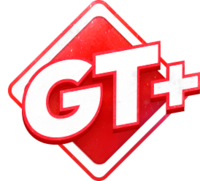In late August, Uri Peleg launched a series of videos about what separates the strongest players from mere mortals. In the first video, he uses a hand between Aleksey “avr0ra” Borovkov and Artem Shaganov as an example to explain how top regs "keep ranges" — that is, they monitor what parts of the range each player in the hand retains as the hand progresses.
This hand was played on GG Network, $10,000 between Aleksey “avr0ra” Borovkov and Artem, both of these guys successful high-stakes players, $20K buy-in. Aleksey raises on the cutoff to 2 and a 2x standard size, and Artem calls from the big blind.
So already, try to imagine the ranges and ask yourselves: How good are you guys at this?
Does Artem have offsuit?
Does he have offsuit?
Does he have suited? Like, where do the borders lie?
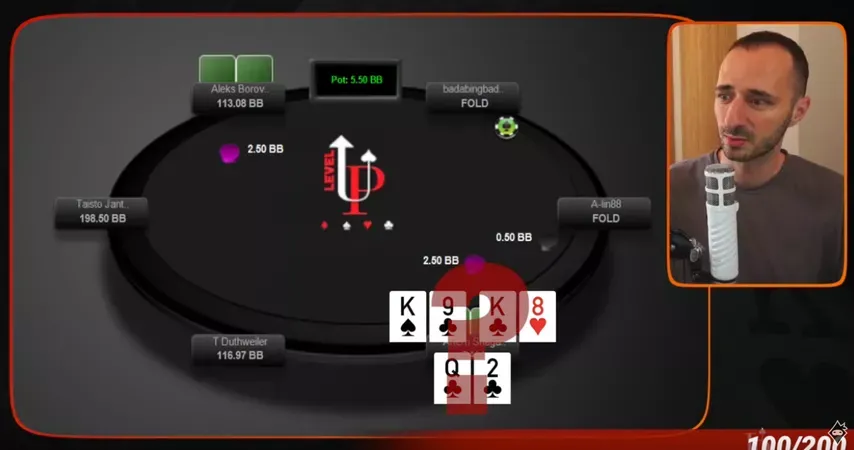
Artem checks. We have two-tone. This is one of those boards where even though the preflop raiser has an advantage, the caller hits and and suited, suited, . So he has enough kind of top-range hands where the in-position player can't go crazy betting everything.
Aleks makes a half-pot bet, which generally speaking is indicative of what we call a polarized range. So he's not betting absolutely everything but doing some kind of merge with stronger weights to his good hands and more check-backs with hands like , , would be the classic examples. So yeah, we have a bet and a call.
The turn is the .
You know, whenever a draw comes in, in general, it has what I call a depolarizing effect. Because generally speaking, when Aleks bets the flop, Artem's going to check-raise most of his good hands, and then on a breaky turn, Aleks is going to have the kind of top range that Artem doesn't anymore, given most of his top hands check-raised. That creates a difference in the tops of the ranges. But once draws come in, top of the range is no longer a set or top pair top kicker, it's now flushes, and both players can have flushes. So this leads to, generally speaking, smaller bet sizes.
Artem checks, Aleks bets 75% pot, and Artem goes for a check-raise, which Aleks calls.

Now, with no theory, what's Artem check-raising? Well, generally flushes and flush blockers, right? Maybe sets, but generally, the check-raising range is centered around the new top range. Just like on the flop you check-raise , on a turn, you can check-raise some flushes and then the appropriate hands to go with that would be hands with one as bluffs.
The river is the
This is a very difficult hand to keep track of ranges. Here Artem goes for a check. Why does he go for a check? Well, generally, if you look at his range, a lot of his flushes are now no longer worth as much money because it's four to a flush. All of his bluffs made a flush, but not necessarily a high one. So the ranges got re-depolarized again, and he might actually be at a bit of a disadvantage. So he actually goes ahead and checks, and Aleks goes all-in.
Now, if I dropped you on this spot with no background and I told you look at your hand, decide whether or not you're going to bluff, and you saw something like two pair or two pair in Aleks' shoes, you would be like, "No, I mean those are not hands that I bluff. Let's check these hands back. I bluff with air. I don't bluff top pair. I don't bluff two pair."
But if you guys kind of roll back to the turn, in Artem's check-raising range, Artem is basically going to have a flush almost always on the river. And if he doesn't have a flush, he certainly has a one-pair hand beat. All his bluffs are going to have a . All his value hands are generally speaking flushes. So how does Artem not have you beat if you have one pair?
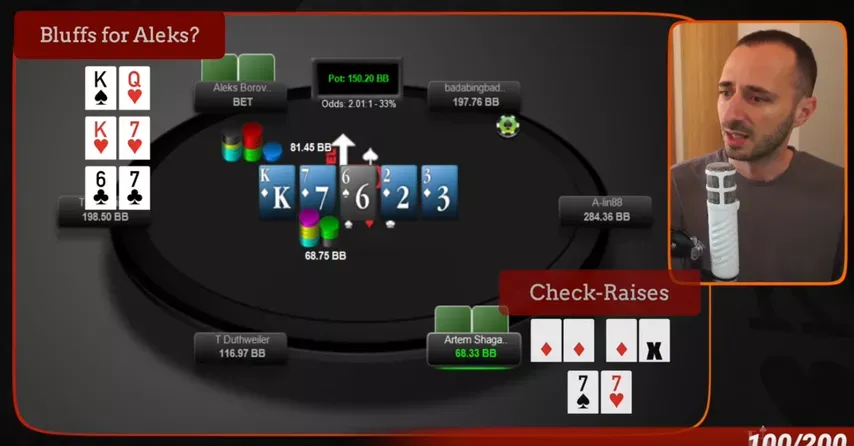
Let this sink in for a second and now look at your and say, "Okay, if I check, I'm actually going to lose 100% of the time. My , my two pair, is just as good as if I had off-suit." Not even as good, because maybe my randomly has a . To realize this, you have to keep very, very good track of the ranges.
So that's why I think this hand illustrates very strongly the concept that I'm trying to drill in this video. This is something that top players are very, very, very good at, and you can see it as they're moving up stakes. They don't have to get it accurate; sometimes they miss by a bit, but they keep track, and this is something they kind of do naturally.
So in this hand, Aleks goes all-in and Artem makes the call. Artem has for the nuts, so, an easy call. Very naturally played hand: check-call a flop, check-raise a turn with the nuts, and he recognized that this is a river where he needs to play more defensively with his range, kind of babysit all of his low flushes because he's going to have a lot of them. So yeah, easy hand for Artem.
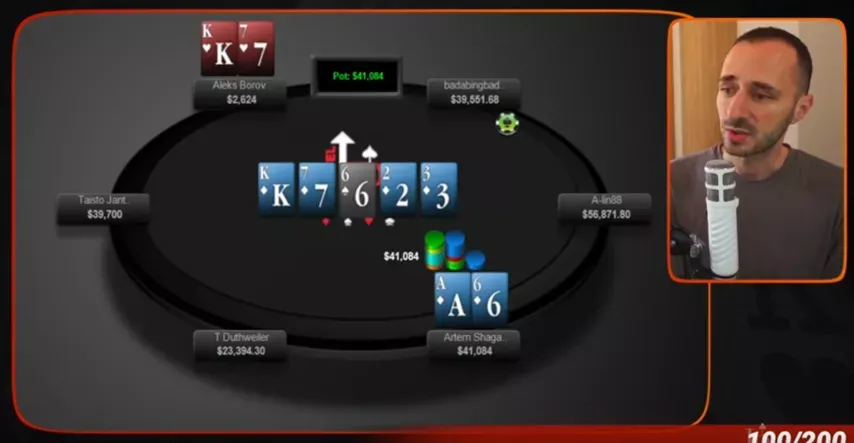
What about Aleks? Aleks shows up with . So flop bet makes sense, turn bet makes sense, although you could also check back on a flush. It's not that strong, and then this is a type of hand that calls a check-raise. The way you think about it is, if he's bluffing, you have him beat, but if he has a flush, you have four outs to a boat. So kind of like calling with a draw, pair, plus gutshot value, as you have four outs to the nuts. So definitely a turn call.
And then on the river, I think Aleks correctly recognized that his hand has zero showdown value and thus makes for a potential bluff, and made a very, very sharp bluff. Whenever I see someone make this kind of bluff, I take note. I know that this is going to be a tough guy to play against. He's very range-aware, he's capable of turning showdown into a bluff in appropriate spots, and the reason I'm saying this is that a lot of people aren't, and people who aren't, you play against them differently.
The People's Opinions
Uri was impressed by Aleksey's bluff, but the subscribers of the GipsyTeam Telegram channel "What's on the River?" frankly, did not appreciate it. No hand has ever been discussed so heatedly in the chat! Here are some quotes:
"Avr0ra knew he wouldn't win, so he gave up the stack."
"Check-raise either flushes or hands with one diamond. Instead of just giving up and saving money, push into nowhere. Where is the understanding of ranges here?"
"Avr0ra went for a full house and, not having reached it, decided to pretend to be an ace"
"To knock out a flush with such a line is really something"
“It seems to me that Artem simply destroyed avr0ra here, because he was very wrong.”
"The second barrel into nowhere, and then it snowballs – a call of the raise because "there could be bluffs" and the cherry on the cake – a "brilliant" push on the river, which turned a solid part of Artem's bluffs into nuts 👏"
Avr0ra's Opinion on His Play
We asked Aleksey himself to comment on the distribution :
"Interesting hand. Not sure I played it well – and judging by the showdown, my bluff was probably bad.
As Uri correctly noted, on the river after Artem's check I have exactly 0 showdown value and the bottom of the range, and there are quite a few nuts in the range. With such factors, it would seem that a bluff cannot be very bad. We must also remember that the cutoff has no right to bet often on such a turn. I would even check my two pair very often, that is, on the river I have very few such combinations.
Artem's range is very strong overall, and it's not at all clear how he builds his blockbet/check range here. It could well be that the percentage of traps is huge. The machine will often bet in his place here itself.
This is what we need to try to assess – and also understand what percentage of the range is made up of low flushes, whether they will definitely fold and whether they raise the turn often enough. In fact, only Artem himself can say for sure whether this is a good bluff or a bad one.
I have a big advantage against him, but this is a unique situation in super-narrow ranges. In general, I can imagine his game plan against me (not necessarily correct, of course), but I can’t extrapolate it to this particular spot (and I couldn’t in the moment). Of course, I understood that for a plusEV bluff I always need to knock out weak flushes and often medium ones.
Against an unknown opponent at lower limits, it is always better to give up, of course."
The Solver's Opinion
Finally, let's look at the solver. The ranges are from GTO Wizard, the calculations are from POSTFLOPIZER.
The machine in Aleksey's place really does push both two pairs and sets on the river as a bluff:
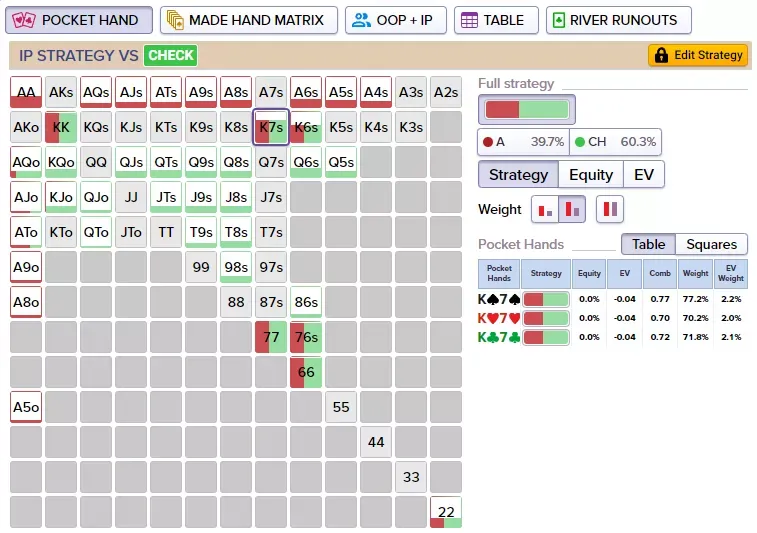
In Artem's place, many flushes fold with varying frequency, including even Q-high:
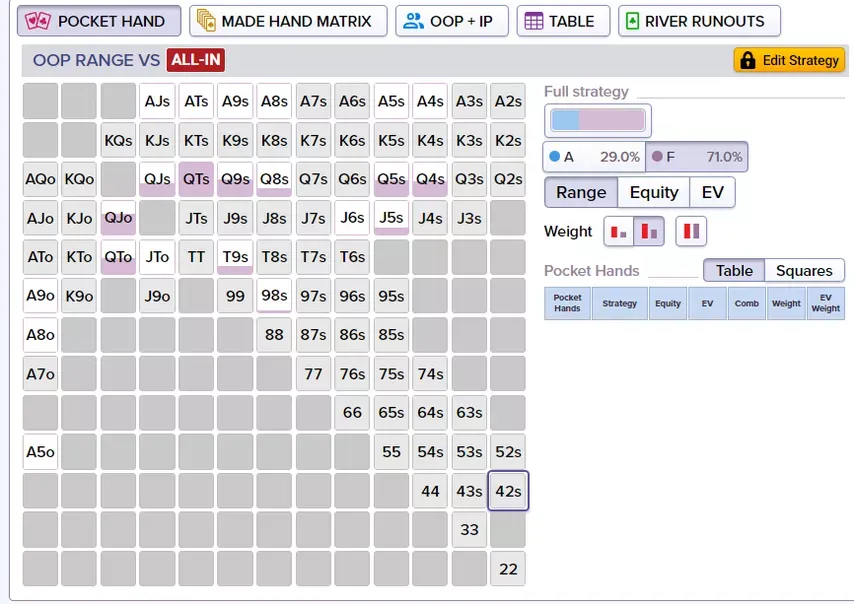
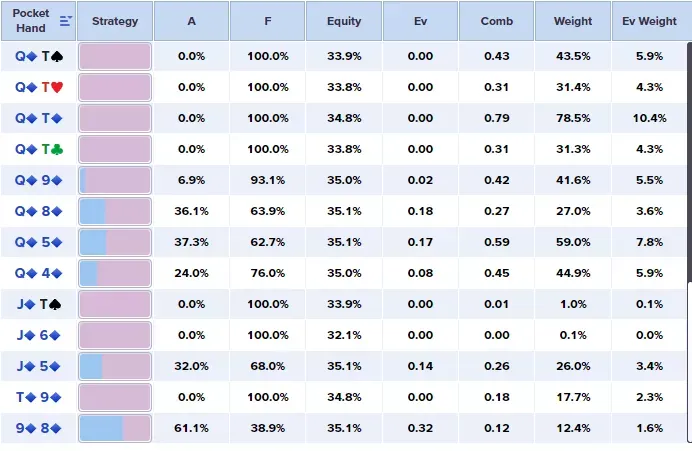
In general, the machine thinks that everything is on point! But this is, as they say, Solverland. In reality, these opponents will most likely never find themselves in such a unique spot again. And if they do, then first of all they probably won't remember GTO, but this hand – and how it ended. It's not boring up there at the high stakes!



